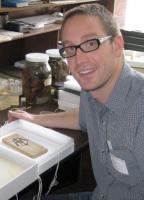Daniel Riskin
Assistant Professor
Building
Marshak Science Building
Office
MR630 (office)
Phone
212-650-8479 (office)
Fax
212-650-8585

Daniel Riskin
Profile
Dr. Riskin studies the ecological and behavioral implications of morphological diversity through biomechanics. His research is focused on the quantification of aerial maneuverability in bats, to understand the functional consequences of variation in body shape. Dr. Riskin studies flight performance in the lab an in the field, mostly using 3D reconstruction from high-speed video.
Education
Ph.D. in Biology, Cornell University, 2006
M.S. in Biology, York University, Canada, 2000
B.Sc. in Zoology, University of Alberta, Canada, 1997
Research Interests
Dr. Riskin is broadly interested in the spectrum of functional consequences that result from morphological diversity. Using experimental biomechanics in the lab and in the field, he seeks to understand how differences in body shape among species influence differences in performance. Bats present an ideal system for this area of research, because while all >1200 species possess body plans that permit flight, subtle variations in body shape underlie striking diversity in almost every aspect of behavior and ecology.
Publications
Swartz, S. M., Iriarte-Díaz, J., Riskin, D. K., and Breuer, K. S. (in press). A bird? A plane? No, it's a bat: an introduction to the biomechanics of bat flight. In Evolutionary History of Bats: Fossils, Molecules, and Morphology. (ed. Gunnell, G. F., and Simmons, N. B.). Cambridge MA: Cambridge University Press.
Iriarte-Díaz, J., Riskin, D. K., Willis, D. S., Breuer, K. S., and Swartz, S. M. (2011). Whole-body kinematics of a fruit bat reveal the influence of wing inertia on body accelerations. Journal of Experimental Biology. Accepted 25 Jan, 2011.
MacAyeal, L. C., Riskin, D. K., Swartz, S. M., and Breuer, K. S. (2011). Vertical flight performance and load carrying in lesser dog-faced fruit bats (Cynopterus brachyotis). Journal of Experimental Biology 214, 786-793.
Riskin, D. K., Iriarte-Díaz, J., Middleton, K. M., Breuer, K. S., and Swartz, S. M. (2010). The effect of body size on the wing movements of pteropodid bats, with insights into thrust and lift production. Journal of Experimental Biology 213, 4110-4122.
Hubel, T. Y., Riskin, D. K., Swartz, S. M., and Breuer, K. S. (2010). Wake structure and wing kinematics: the flight of the lesser dog-faced fruit bat, Cynopterus brachyotis. Journal of Experimental Biology 213, 3427-3440.
Parsons, S., Riskin, D. K., and Hermanson, J. W. (2010). Echolocation call production during aerial and terrestrial locomotion by New Zealand's enigmatic lesser short-tailed bat, Mystacina tuberculata. Journal of Experimental Biology 213, 551-557.
Riskin, D. K., and Racey, P. A. (2010). How do sucker-footed bats hold on, and why do they roost head-up? Biological Journal of the Linnean Society 99, 233-240.
Riskin, D. K., Bahlman, J. W., Hubel, T. Y., Ratcliffe, J. M., Kunz, T. H., and Swartz, S. M. (2009). Bats go head-under-heels: the biomechanics of landing on a ceiling. Journal of Experimental Biology 212, 944-953.
Riskin , D. K., Willis, D. J., Iriarte-Diaz, J., Hedrick, T. L., Kostandov, M., Chen, J., Laidlaw, D. H., Breuer, K. S., and Swartz, S. M. (2008). Quantifying the complexity of bat wing kinematics. Journal of Theoretical Biology 254, 604-615.
Williams, W. O., Riskin, D. K., and Mott, K. M. (2008). Ultrasonic sound measurement as an indicator of acute pain in laboratory mice. Journal of the American Association of Laboratory Animal Scientists 47, 8-10.
Riskin, D. K., Parsons, S., Schutt, W. A. Jr., Carter, G. G., and Hermanson, J. W. (2006). Terrestrial locomotion of the New Zealand Short-tailed Bat Mystacina tuberculata and the Common Vampire Bat Desmodus rotundus. Journal of Experimental Biology 209, 1725-1736.
Carter, G. G., and Riskin, D. K. (2006). Mystacina tuberculata. Mammalian Species 790, 1-8.
Riskin, D. K., Bertram, J. E. A. and Hermanson, J. W. (2005). Testing the hindlimb-strength hypothesis: Non-aerial locomotion by Chiroptera is not constrained by the dimensions of the femur or tibia. Journal of Experimental Biology 208, 1309-1319.
Riskin, D. K. and Hermanson, J. W. (2005). Independent evolution of running in vampire bats. Nature 434, 292.
Riskin, D. K. and Fenton, M. B. (2001). Sticking ability in Spix's disk-winged bat, Thyroptera tricolor (Microchiroptera: Thyropteridae). Canadian Journal of Zoology 79, 2261-2267.
Riskin, D. K. (2001). Pipistrellus bodenheimeri. Mammalian Species 651, 1-3.
Fenton, M. B., Bernard, E., Bouchard, S., Hollis, L., Johnston, D. S., Lausen, C. L., Ratcliffe, J. M., Riskin, D. K., Taylor, J. R. and Zigouris, J. (2001). The bat fauna of Lamanai, Belize: roosts and trophic roles. Journal of Tropical Ecology 17, 511-524.
Fenton, M. B., Vonhof, M. J., Bouchard, S., Gill, S. A., Johnston, D. S., Reid, F. A., Riskin, D. K., Standing, K. L., Taylor, J. R. and Wagner, R. (2000). Roosts used by Sturnira lilium (Chiroptera: Phyllostomidae) in Belize. Biotropica 32, 729-733.
Riskin, D. K. and Pybus, M. J. (1998). The use of exposed diurnal roosts in Alberta by the little brown bat, Myotis lucifugus. Canadian Journal of Zoology 76, 767-770.